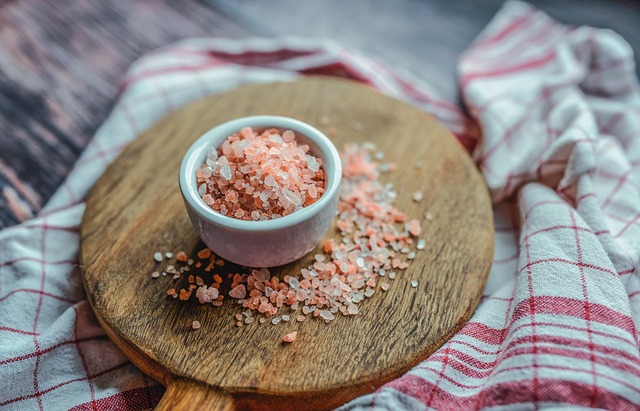Even though it contains “Himalayan” in its name, Himalayan pink salt is mainly sourced from Pakistan. This type of salt is highly desired for its attractive pink color and promoted as a better alternative to table salt.
Although Himalayan pink salt may have slightly more essential nutrients like magnesium, it lacks a significant amount to have a considerable effect. In terms of nutrition, this attractive salt is nearly identical to regular salt.
Although numerous individuals promote the health advantages of Himalayan sea salt, such as decreased sodium levels and a wider range of crucial minerals and elements compared to typical table salt, there is scarce proof to support these health assertions.
Why does the body need salt
Salt contains the essential trace mineral sodium, which is required by the body for various functions. Sodium can aid in:
- contracting and relaxing muscles
- maintaining proper fluid balance and preventing dehydration
- sending nervous system impulses
- preventing low blood pressure
According to recent studies, the consumption of salt may lower the possibility of getting infected and eliminate harmful bacteria. Additionally, the findings from an animal-based study have prompted scientists to speculate that salt may have a beneficial impact on depression symptoms.
Himalayan Pink Salt
Hailing from the distant Punjab region of Pakistan, situated south of Islamabad within the Salt Range mountains, is the Himalayan pink salt that is extracted through mining. The pink hue of this type of rock salt is caused by impurities that are present within it. For several centuries- at least since the 1200s- it has been extracted and utilized for culinary processes and food preservation.
Himalayan pink salt owes its pink hue to the trace minerals present in it, varying from a delicate shade of pink to a more intense and diverse pink. When the pink salt is finely ground, its color appears lighter compared to the coarse variety that is used in salt grinders.
Although Himalayan pink salt has occasionally been promoted as Jurassic sea salt, it actually formed much earlier than that era. Despite originating from a sea, the sea dried up a long time ago, causing salt deposits to accumulate in the mountains.
Pink Salt Nutrition
Regular table salt and Himalayan pink salt have similar chemical compositions as they both contain the compound sodium chloride (NaCl). According to the United States Department of Agriculture (USDA), every 1/4 teaspoon of regular table salt includes 581 milligrams of sodium, while 1/4 teaspoon of Himalayan pink salt contains 388 milligrams of sodium.
The reason for this difference is that pink salt has a coarser grind, which makes it less dense than regular table salt. However, when measured by weight, they contain the same amount of sodium.
Minerals in Himalayan Pink Salt
Himalayan pink salt possesses additional minerals and components which are not present in common table salt. Such as, it comprises small traces of potassium, calcium, and magnesium, nutrients that play a vital role in maintaining good health. Nevertheless, the total quantity present is minimal.
The absence of ample levels of calcium, potassium, and magnesium in Himalayan pink salt means that it is not impactful for improving your health.
Although most Himalayan pink salt brands declare on their nutrition facts labels that their salt servings contain 0% daily value for certain nutrients, this could be slightly deceptive, since the salt does contain a small amount of all three nutrients. Nevertheless, since any of these minerals in a serving amounts to less than 1%, the label must declare the content as zero.
Consuming about 4.6 teaspoons of Himalayan pink salt, which is equivalent to one ounce, can provide you with approximately 6% of the recommended daily iron intake. Nevertheless, it is an injurious amount of salt to consume for acquiring a meager amount of iron. Though some manufacturers argue that Himalayan pink salt carries numerous trace minerals, there is scant external research to support this claim.
It’s worth mentioning that Himalayan pink salt does not contain added iodine, unlike several other types of table salt. While most Americans consume enough iodine, certain groups may be prone to iodine deficiency, such as:
- People who are pregnant
- Vegans
- People who consume few dairy products or eggs
Himalayan Salt Benefits
- Helps reduce sodium in foods
- Additive free
- Lights used for halotherapy
- Exfoliates skin
Although Himalayan pink salt does not provide any additional nutritional benefits, it should not be disregarded. Many individuals prefer the taste of pink salt over regular table salt. In its coarse state, pink salt contains less sodium per teaspoon, which could potentially lead individuals to use less salt for flavoring purposes and, ultimately, decrease their sodium consumption.
Himalayan salt, which is free from additives unlike table salt often containing anti-caking agents, may be preferred by some individuals. Additionally, a valid reason to purchase this salt is due to its enjoyable pink hue.
Using Himalayan pink salt instead of regular table salt is a healthy option, but it’s important to remember that any promises of essential mineral benefits are unsupported by evidence.
Rich mineral content
It has been reported by certain sources that pink Himalayan salt comprises of as many as 84 distinct trace minerals.
With sodium chloride making up 98 percent of its composition, only about 2 percent accounts for the presence of trace minerals. Since people consume salt in small amounts and the quantity of minerals present is negligible in salt, there is little chance of gaining any notable health-related advantages from them.
Lower sodium
Although there is a belief that pink Himalayan salt has less sodium than table salt, both have a similar composition of around 98% sodium chloride.
Pink salt’s larger crystal size makes its sodium content per teaspoon lower, and its saltier taste allows for less salt to be used to achieve a similar flavor as table salt.
It’s important to note that pink salt can be found in a finer granule size that is similar to regular salt. This should be taken into account when seasoning dishes and monitoring sodium consumption.
According to the American Heart Association (AHA), more than 75 percent of the sodium consumed comes from processed and prepared foods, not from table salt, which accounts for only a small portion of the sodium content in meals.
A more natural salt
It has been suggested by some that Himalayan salt is a more natural alternative to table salt, and this claim seems to hold validity. Table salt is typically subjected to intense refining processes and combined with additives like sodium aluminosilicate or magnesium carbonate to counteract clumping.
Typically, Himalayan salt is less processed and free from additives.
An aid to hydration
Some believe that adding a pinch of pink salt to meals or drinks can help the body achieve optimal fluid balance and prevent dehydration. It is true that sodium is necessary to maintain proper fluid balance. However, this is true of sodium from other sources as well as pink Himalayan salt.
If you decide to use pink Himalayan salt, keep the following points in consideration.
Iodine intake
The thyroid glands require iodine for support, but pink salt is not the best option for those who lack iodine as it contains less of the mineral compared to table salt. Iodine is an essential mineral necessary for maintaining proper thyroid function and cellular metabolism. Excellent food sources of iodine comprise sea vegetables, fish, dairy, and eggs.
This trace mineral can also be found in iodized salt, which is used in around 75 percent of households in the United States.
Pink Himalayan salt may have a small amount of iodine naturally, but it is anticipated to have a lower quantity of iodine compared to iodized salt. As a result, individuals who suffer from iodine insufficiency or are vulnerable to it may have to look for other sources of iodine if they use pink salt instead of table salt.
Sodium intake
Although sodium is necessary for preserving life, it is important to monitor the intake of any type of salt. While sodium is necessary in small quantities, too much can have a negative impact on health.
Individuals who have kidney, heart, or liver problems, or those following a low-sodium diet, ought to supervise their sodium consumption and restrict their usage of all varieties of salt, such as pink Himalayan salt.
It is important to keep track of sodium intake even if one is healthy. According to the Centers for Disease Control and Prevention’s (CDC) 2016 report, more than the suggested sodium intake level is consumed by 89 percent of adults and over 90 percent of children.
Too much sodium
The Dietary Guidelines for Americans from 2015 to 2020 advise individuals to consume no more than 2,300 milligrams (mg) of sodium daily, which is equivalent to approximately one teaspoon of regular table salt per day. For those with hypertension, the recommended sodium intake is limited to 1500 mg per day. To reduce sodium consumption, consult a dietician for dietary modifications.
Knowing that salt contains 40 percent sodium can aid in being mindful of sodium consumption. It is useful to be aware of the quantity of sodium in varying amounts of salt. The ensuing are the quantities of sodium present in specific doses of salt:
- 1/4 teaspoon salt: 575 mg sodium
- 1/2 teaspoon salt: 1,150 mg sodium
- 3/4 teaspoon salt: 1,725 mg sodium
- 1 teaspoon salt: 2,300 mg sodium
This amount is exceeded by a majority of individuals.
If individuals consume an excess of sodium, their kidneys will attempt to eliminate it through their urine. In cases where the kidneys are unable to eliminate a sufficient amount of sodium, it accumulates in the interstitial fluid, which is the fluid between cells.
Excessive consumption of sodium leads to elevated water and blood volume, which places extra burden on the heart and blood vessels. Various severe health issues are connected with a high intake of sodium, such as:
- high blood pressure
- heart disease
- stroke
- liver damage
- osteoporosis
- kidney disease
The excessive consumption of salt may lead to autoimmune disorders such as lupus, psoriasis, rheumatoid arthritis, and multiple sclerosis by overstimulating the immune system. According to a study conducted in 2015, there is a clear correlation between salt intake and obesity, with an increase of over 25 percent in the risk of obesity in both children and adults for each additional gram of salt consumed per day.
Other Himalayan Salt Products
In addition to dietary options, Himalayan pink salt products also come in non-edible forms. Despite lack of solid proof for their efficacy, salt lamps, salt therapy, and pink salt bath scrubs are popular among many users. A salt lamp refers to a sizable salt block with a central light source, purportedly capable of both germ-killing and air-purifying effects.
Halotherapy, or salt therapy, is gaining popularity with the use of pink salt rooms and caves. During this therapy, individuals sit in an environment filled with salt and breathe in salty air, which is believed to have multiple health benefits on the body.
Some body scrubs and bath salts incorporate pink salt in their formulas, purportedly for its ability to alleviate muscle pain and provide skin exfoliation and hydration.
Use Pink Salt
This variety of salt is utilized in a similar manner as regular table salt – for cooking purposes, enhancing flavors, and as a method of food preservation.
Pink salt blocks can serve as utensils for serving, cooking and cutting. Additionally, pink Himalayan salt can be utilized as an alternative to bath salts, and pink salt lamps and candleholders can also be purchased.
Using Himalayan pink salt in cooking and food preparation does not require any special instructions, as it is nutritionally similar to table salt. It can be used interchangeably and can be poured into any salt shaker. Nevertheless, some may prefer the texture of coarse salt, which can be used to season meat or vegetables. Additionally, a decorative salt grinder can be utilized for a decorative touch.
One can utilize a Himalayan pink salt block for both cooking and serving purposes. The salt block comes in distinct sizes and shapes, which enables it to maintain heat for a longer duration. Given this, the salt block is an excellent choice for cooking and baking meats, seafood, fruits, vegetables, and baked items. Additionally, it can be refrigerated and utilized to serve cold dishes.
Keeping an eye on your salt intake is crucial. Excessive amounts of sodium could increase the likelihood of developing hypertension, which, in flipside, may ups the risk factors for heart disease, stroke, and related health issues. The suggested dietary guidelines for Americans propose a daily sodium intake of 2,300 mg or less. Sadly, the statistics highlight that Americans tend to consume approximately 3,393 mg of sodium in a day on average.
There is currently no scientific proof that pink Himalayan salt offers greater health advantages than regular table salt. Opting for pink Himalayan salt crystals instead of finely-ground table salt may aid in lowering sodium consumption, but as with all salt, it’s important to consume it in moderation.



